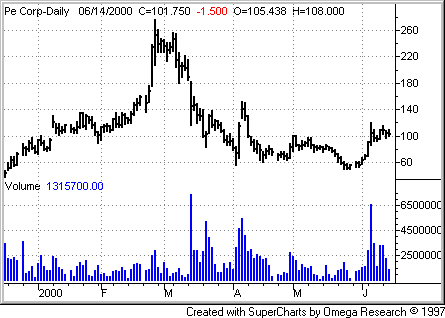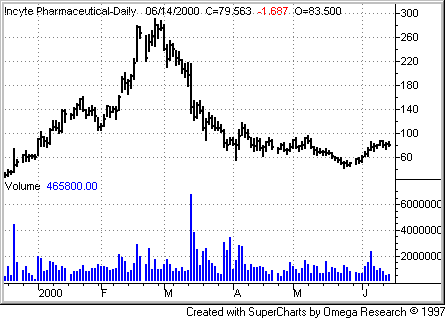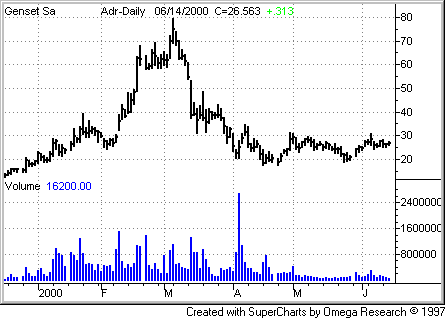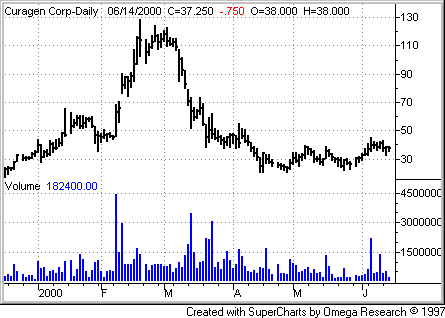Profiting From The Human Genome
As Celera
is poised to announce its completion of the entire human genome, the worldwide $350 billion-plus pharmaceutical market is there for the taking. With
its announcement of having finished sequencing the three-billion-base-pair human genome, Celera will usher in a new era in pharmaceutical development — an era characterized by the development of new drugs based on gene discovery and gene technology. Drugs that will be able to target and even cure difficult diseases such as cancer and diabetes. These novel drugs will have minimal side effects and be tailored to our individual genetic profile. Dr. George Rathman, one of the founders of Genetech and a pioneer in biotechnology, said it best: “The most difficult thing in the industry is trying to predict the human response to a drug.” The genetic information about to be released will make this task much easier. Genomic-based drugs will be unlike anything on the market today. These companies are about to enter a new era characterized by unlimited growth.
Despite the promise, the unveiling of the information in our genome is only the first step. Once companies like Celera reveal the basic letters of our genetic code, they then have to be placed in the correct order to help identify important normal and abnormal genes. Once these genes are identified, companies need to figure out what they do. This leads to an entirely new area called
Functional Genomics, an area where many companies are active today, especially as it relates to understanding disease. Once a gene function is determined, the proteins it codes for must be identified. It is from these proteins, particularly in diseased-linked genes, that many of the drugs of the future will emerge. This too is an entirely new area called
proteomics, the study of protein structure and function. Many companies are actively developing proteomic platforms and technology in anticipation of its demand.
With the announcement, we are entering a new informational genetic era. This era will give birth to many new companies involved in every aspect of genomic technology. As I mentioned in my new book on
Profiting From The Human Genome, the companies leading the way are the “Gene Hunters.” They are the ones with access to the raw genetic material necessary to start the new drug development process. They are the ones building vast genetic databases, libraries in demand from the smallest biotech company to the largest pharmaceutical company. At the end of the day, the companies hunting genes hold the keys to what will be the most profitable doors in biopharmaceutical history. Over the next several weeks, I will highlight many of these companies involved in every aspect of genomic technology. This article will focus on the gene hunters.
Celera Genomics
(
CRA |
Quote |
Chart |
News |
PowerRating)
Celera is the leading gene hunter on the cusp of deciphering the entire human genome. Its shotgun sequencing technology has cut years off the time needed to complete the human chromosome project. The company has sequenced the DNA of several major microorganisms, such as the common fruit fly. The foundation of basic genetics today comes from our understanding of this organism. Celera’s latest project is the mouse genome. The mouse and human genome share many of the same genes. By sequencing the mouse genome, Celera will be able to use this information to help interpret the function of newly discovered human genes. The company is creating a large database of genetic information that will create the foundation for the many drugs of the future. Celera has several dozen genetic patents to its credit, with several thousand more pending. The company generates revenue by charging access fees to its database. It has several major pharmaceutical companies as clients, paying $10 million each year, the most recent being
Vanderbilt University. Celera is also looking beyond sequencing genes and is developing a platform to identify many of the protein products of these genes. They are diversifying into proteomics. This is important as it relates to identifying diseased proteins and developing drugs against them.

Incyte Pharmaceuticals
(
INCY |
Quote |
Chart |
News |
PowerRating)
Incyte Pharmaceuticals is one of the oldest gene-hunting companies in the business. It has been around since the early 1990s and is amassing an impressive library of DNA sequences called LifeSeq Gold. The company specifically identifies expressed sequence tags or ESTs, fragments of DNA whose signature can be linked to the function of a specific normal or diseased gene. Incyte has close to 500 patents on unique ESTs, with over 6000 more pending. ESTs are especially important in identifying disease-linked genes, the first step in the development of new treatments. Incyte played a major role in identifying a gene which controls the production of HDL cholesterol, the “good” blood cholesterol. By using knowledge from this gene, Incyte has the potential to develop a new treatment for high cholesterol that will rival Warner-Lambert’s blockbuster drug, Lipitor.
Like Celera, Incyte will generate revenue from access fees to its proprietary genetic information and any new drugs that result.

Genset SA
(
GENXY |
Quote |
Chart |
News |
PowerRating)
Genset is a French firm that has identified several genes related to prostate cancer, asthma, heart disease, and diabetes. The company is creating a database of
genetic material that could be used for future drug development. It has numerous collaborative relationships with other biotech companies, offering access to its growing databank. Although not as well known as Celera or Incyte, this company is Europe’s leading gene hunter.

Genome Therapeutics
(
GENE |
Quote |
Chart |
News |
PowerRating)
This Massachusetts-based company is applying its gene-sequencing techniques to the treatment of bacterial and fungal infections, as well as asthma. It is developing a database of genetic information on different organisms in order to develop the next generation of antibiotics. The company is also building a library of genes and gene products in order to offer access to major pharmaceutical companies for new drug development. Genome Therapeutics doesn’t have the broad scope of a Celera or Incyte and is trying to create a niche market for its genetic information.
Curagen
(
CRGN |
Quote |
Chart |
News |
PowerRating)
Curagen is a growing force in the gene-hunting business and is establishing a presence in the next phase of Genomics, the study of gene proteins. The company has created a databank of over 70,000 gene sequences and has developed the platform to establish what these genes do. Curagen was the first company to elucidate the first protein-interaction map of a living organism, yeast. It was able to sequence the genes in the yeast organism and define the function of those genes based on the proteins they produced. It hopes to apply this technology to the genes identified in the human genome as it relates to identifying new drug targets and, ultimately, new drugs. Curagen is actively researching the basis of Alzheimer’s disease and has established multiple strategic alliances with many major biotech and pharmaceutical companies. Curagen is not just a pure gene-hunting company. Its research platform is diversified to include technology to analyze the products of genes. This is important and will place Curagen in a good position to take advantage of the next phase of the genomic revolution.

Diversa
(
DVSA |
Quote |
Chart |
News |
PowerRating)
This company collects and stores genetic samples from thousands of organisms worldwide. It plans to apply its patented gene-screening technology to library genes for future agricultural and pharmaceutical use. It is also storing genetic information from different human tissues as well. Diversa has several strategic alliances with the likes of Novartis, Dow Chemical, and Rhone-Poulenc in order to generate revenue from access to its databank.
The companies I have mentioned focus their attention on sequencing genes that may turn out to be useful in developing new drugs to treat a wide range of diseases. Once the entire human genome is mapped, many of these companies will be in position to mine this information for potentially useful genes. Much of their revenue will be generated from access fees to their databank of genetic information and potential future royalties from drugs developed from that information.
In my next article, I will focus on those companies with technology to identify what researchers call single nucleotide polymorphisms or SNPs. SNPs are small sequences of DNA that make each of us individuals in regard to genetic makeup. They are important in identifying the small changes in abnormal genes which lead to many of the major diseases today. The
identification of SNPs will play a prominent role in many of the new drugs which evolve from the genomic industry in the future.
